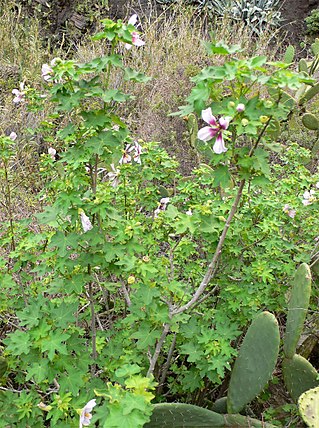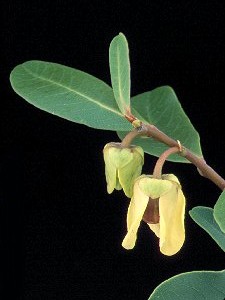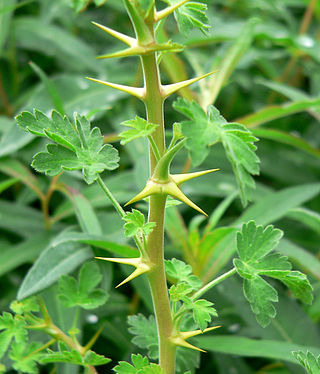
Asteraceae is a large family of flowering plants that consists of over 32,000 known species in over 1,900 genera within the order Asterales. The number of species in Asteraceae is rivaled only by the Orchidaceae, and which is the larger family is unclear as the quantity of extant species in each family is unknown. The Asteraceae were first described in the year 1740 and given the original name Compositae. The family is commonly known as the aster, daisy, composite, or sunflower family.

Silene virginica, the fire pink, is a wildflower in the pink family, Caryophyllaceae. It is known for its distinct brilliant red flowers. Fire pink begins blooming in late spring and continuing throughout the summer. It is sometimes grown in wildflower, shade, and rock gardens.

Arctous alpina, the alpine bearberry, mountain bearberry or black bearberry, is a dwarf shrub in the heather family Ericaceae. The basionym of this species is Arbutus alpinaL..

Dicentra cucullaria, Dutchman's britches, or Dutchman's breeches, is a perennial herbaceous plant, native to rich woods of eastern North America, with a disjunct population in the Columbia Basin.

Malva acerifolia, also frequently known under the synonyms Lavatera acerifolia or Malva canariensis is a shrub endemic to the Canary Islands, belonging to the family Malvaceae.

Eremophila youngii is a flowering plant in the figwort family, Scrophulariaceae and is endemic to Western Australia. It is a dense, erect shrub with many of its parts covered with a layer of grey to yellowish-grey scales and with pink, purple or red flowers.
This page provides a glossary of plant morphology. Botanists and other biologists who study plant morphology use a number of different terms to classify and identify plant organs and parts that can be observed using no more than a handheld magnifying lens. This page provides help in understanding the numerous other pages describing plants by their various taxa. The accompanying page—Plant morphology—provides an overview of the science of the external form of plants. There is also an alphabetical list: Glossary of botanical terms. In contrast, this page deals with botanical terms in a systematic manner, with some illustrations, and organized by plant anatomy and function in plant physiology.

Asimina tetramera, commonly known as the four-petal pawpaw, is a rare species of small tree or perennial shrub endemic to Martin and Palm Beach Counties in the state of Florida. The species is currently listed as endangered under the Endangered Species Act and as endangered by the International Union for Conservation. The four-petal pawpaw is part of the family Annonaceae alongside other Asimina species.

Bossiaea walkeri, commonly known as cactus bossiaea, cactus pea, or Walker's stick bush, is a species of flowering plant in the pea family (Fabaceae) and is endemic to southern mainland Australia. It is a rigid, much-branched shrub with flattened, winged cladodes and red, pea-like flowers between July and November in the species' native range.
This glossary of botanical terms is a list of definitions of terms and concepts relevant to botany and plants in general. Terms of plant morphology are included here as well as at the more specific Glossary of plant morphology and Glossary of leaf morphology. For other related terms, see Glossary of phytopathology, Glossary of lichen terms, and List of Latin and Greek words commonly used in systematic names.

Kunzea pulchella, commonly known as granite kunzea, is a flowering plant in the myrtle family, Myrtaceae and is endemic to the south-west of Western Australia. It is a shrub with spreading branches, egg-shaped to lance-shaped leaves and loose groups of red flowers, each on a short stalk so that the branch is visible between the flowers.

Coprosma rhamnoides is an endemic shrub in New Zealand. It forms a small shrub up to 2 m tall. The leaves are very small, simple and variable in shape. The inconspicuous flowers are unisexual and believed to be wind pollinated. It is widespread in occurrence and can be the dominant small leaved divaricating shrub in some locations

Ribes montigenum is a species of currant known by the common names mountain gooseberry, alpine prickly currant, western prickly gooseberry, and gooseberry currant. It is native to western North America from Washington south to California and east as far as the Rocky Mountains, where it grows in high mountain habitat types in subalpine and alpine climates, such as forests and talus. It is a spreading shrub growing up to 1.5 meters tall, the branching stems covered in prickles and hairs and bearing 1 to 5 sharp spines at intervals.

Scleranthus annuus is a species of flowering plant in the family Caryophyllaceae known by the common names German knotweed and annual knawel. It is native to Europe, Asia, and North Africa, and it is known throughout the rest of the temperate world as an introduced species and a common weed. It grows in many types of habitat, often in disturbed areas.
A member of the family Magnoliaceae, Magnolia nana is an evergreen shrub that produces white or cream colored flowers. It can grow to be 2–3 ft (61–91 cm) in height and 2–3 ft (61–91 cm) in width. The Dwarf Magnolia is native to South East Asia, specifically Vietnam. It grows in most moderate climates, but cannot withstand dryness or drought. Magnolia nana grows best in well drained, partially alkaline soil, with exposure to partial sunlight.
Eremophila clavata is a flowering plant in the figwort family, Scrophulariaceae and is endemic to the south-west of Western Australia. It is a low, dense, spreading shrub with narrow grey, club-shaped leaves and pink to purple, sometimes blue flowers.

Eremophila stenophylla is a flowering plant in the figwort family, Scrophulariaceae and is endemic to Queensland. It is a broom-like shrub or small tree with narrow leaves and pink to brick-red flowers, which grows in the far south-west of the state.
Verticordia paludosa is a flowering plant in the myrtle family, Myrtaceae and is endemic to the south-west of Western Australia. It is an openly branched shrub with small leaves and pink to magenta flowers with spreading, feathery sepals and erect, fringed petals in summer and autumn.

Tetratheca pilosa is a flowering plant in the family Elaeocarpaceae, endemic to Australia. It is a small shrub found in dry sclerophyll forests, open heathlands and woodlands of Australia. It was first recorded in 1805 by French botanist Jacques Labillardière.

Leionema microphyllum, commonly known as limestone phebalium, is a small shrub with terminal clusters of white-pink flowers in spring. It is a rare plant in Victoria and South Australia.















